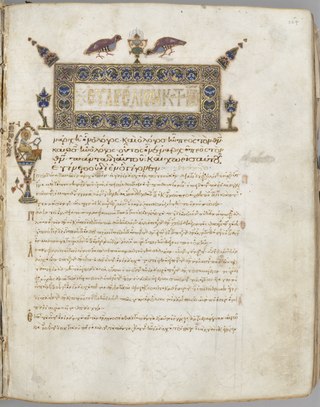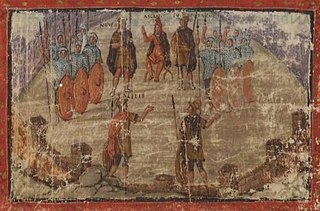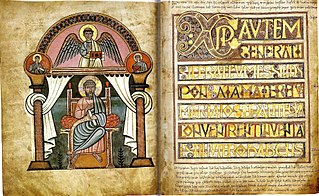
An illuminated manuscript is a formally prepared document where the text is decorated with flourishes such as borders and miniature illustrations. Often used in the Roman Catholic Church for prayers and liturgical books such as psalters and courtly literature, the practice continued into secular texts from the 13th century onward and typically include proclamations, enrolled bills, laws, charters, inventories, and deeds.

The Codex Vaticanus, designated by siglum B or 03, δ 1, is a Christian manuscript of a Greek Bible, containing the majority of the Greek Old Testament and the majority of the Greek New Testament. It is one of the four great uncial codices. Along with Codex Alexandrinus and Codex Sinaiticus, it is one of the earliest and most complete manuscripts of the Bible. Using the study of comparative writing styles (palaeography), it has been dated to the 4th century.

The Vatican Apostolic Library, more commonly known as the Vatican Library or informally as the Vat, is the library of the Holy See, located in Vatican City, and is the city-state's national library. It was formally established in 1475, although it is much older—it is one of the oldest libraries in the world and contains one of the most significant collections of historical texts. It has 75,000 codices from throughout history, as well as 1.1 million printed books, which include some 8,500 incunabula.

Rustic capitals is an ancient Roman calligraphic script. Because the term is negatively connoted supposing an opposition to the more 'civilized' form of the Roman square capitals, Bernhard Bischoff prefers to call the script canonized capitals. The script was used for writing secular texts.

The Vergilius Vaticanus, also known as Vatican Virgil, is a Late Antique illuminated manuscript containing fragments of Virgil's Aeneid and Georgics. It was made in Rome in around 400 CE, and is one of the oldest surviving sources for the text of the Aeneid. It is the oldest and one of only three ancient illustrated manuscripts of classical literature.

The Quedlinburg Itala fragment is a fragment of six folios from a large 5th-century illuminated manuscript of an Old Latin Itala translation of parts of 1 Samuel of the Old Testament. It was probably produced in Rome in the 420s or 430s. It is the oldest surviving illustrated biblical manuscript and has been in the Berlin State Library since 1875-76. The pages are approximately 305 x 205 mm large.

The Vergilius Romanus, also known as the Roman Vergil, is a 5th-century illustrated manuscript of the works of Virgil. It contains the Aeneid, the Georgics, and some of the Eclogues. It is one of the oldest and most important Vergilian manuscripts. It is 332 by 323 mm with 309 vellum folios. It was written in rustic capitals with 18 lines per page.

British Library, Harley MS 1775 is an illuminated Gospel Book produced in Italy during the last quarter of the 6th century. The text is in Latin and is a mixture of the Vulgate and Old Latin translations. This text is called "source Z" in critical studies of the Latin New Testament.

The Vespasian Psalter is an Anglo-Saxon illuminated psalter decorated in a partly Insular style produced in the second or third quarter of the 8th century. It contains an interlinear gloss in Old English which is the oldest extant English translation of any portion of the Bible. It was produced in southern England, perhaps in St. Augustine's Abbey or Christ Church, Canterbury or Minster-in-Thanet, and is the earliest illuminated manuscript produced in "Southumbria" to survive.

The Codex Aureus of Lorsch or Lorsch Gospels is an illuminated Gospel Book written in Latin between 778 and 820, roughly coinciding with the period of Charlemagne's rule over the Frankish Empire. Both the manuscript and the carved ivory panels from the cover are rare and important survivals from the art of this period.

The Stockholm Codex Aureus is a Gospel book written in the mid-eighth century in Southumbria, probably in Canterbury, whose decoration combines Insular and Italian elements. Southumbria produced a number of important illuminated manuscripts during the eighth and early ninth centuries, including the Vespasian Psalter, the Stockholm Codex Aureus, three Mercian prayer books, the Tiberius Bede and the British Library's Royal Bible.

The Fécamp Bible is an illuminated Latin Bible. It was produced in Paris during the third quarter of the 13th century, and had previously belonged in the collection of Henry Yates Thompson.
Codex Vaticanus Graecus 2061, usually known as Uncial 048, α1 (Soden), is a Greek uncial manuscript on parchment. It contains some parts of the New Testament, homilies of several authors, and Strabo's Geographica. Formerly it was known also as the Codex Basilianus 100, earlier as Codex Patriniensis 27. It was designated by ב a, p.
The Codex Vaticanus is one of the oldest and most valuable extant manuscripts of the Greek Bible. In addition to that most common reference, however, the term may refer to any other of the manuscripts preserved in the Vatican Library, a partial list of which follows:

The Vatican Terence, or Codex Vaticanus Latinus 3868, is a 9th-century illuminated manuscript of the Latin comedies of Publius Terentius Afer, housed in the Vatican Library. According to art-historical analysis the manuscript was copied from a model of the 3rd century. The manuscript is referred to in the apparatus criticus of modern editions as "C".

The Alphabetum Romanum, by Felice Feliciano, published in 1463, is a text that covers how to create Roman square capital letters geometrically based on the subdivision of a square.

The Codex Wittekindeus is a 128-folio illuminated Gospel Book, produced in Fulda Abbey in Germany around 970–980. Alongside the Gero Codex, the Codex Wittekindeus is considered one of the two "greatest works in the initial Ottonian revival of book-illumination".

The Emperor's Bible, also known as Codex Caesareus, Codex Caesareus Upsaliensis or the Goslar Gospels, is an 11th-century illuminated manuscript currently in Uppsala University Library, Sweden. Despite its name, it is not a Bible but a Gospel Book. The book was made in the scriptorium of Echternach Abbey, and is one of four preserved large Gospel Books made there during the 11th century. It was commissioned by Emperor Henry III and donated by him to Goslar Cathedral, where it remained until the Thirty Years' War. It was then lost for about 100 years. Its previous richly decorated cover was also lost at this time at the latest. The book later appeared again in the possession of Swedish diplomat and civil servant Gustaf Celsing the Elder. At the death of his son, it was acquired by Uppsala University.
The Fragmenta Vaticana are the fragments of an anonymous Latin work on Roman law written in the 4th century AD. Their importance to scholars stems from their being untouched by the Justinianic reforms of the 6th century.


















